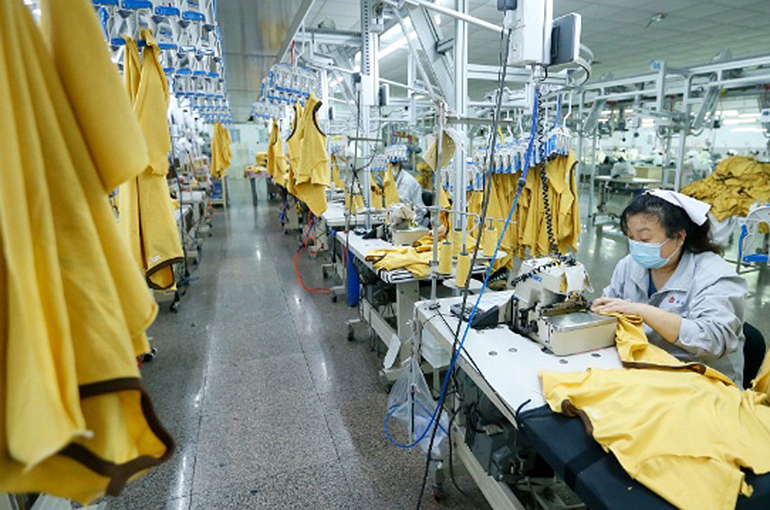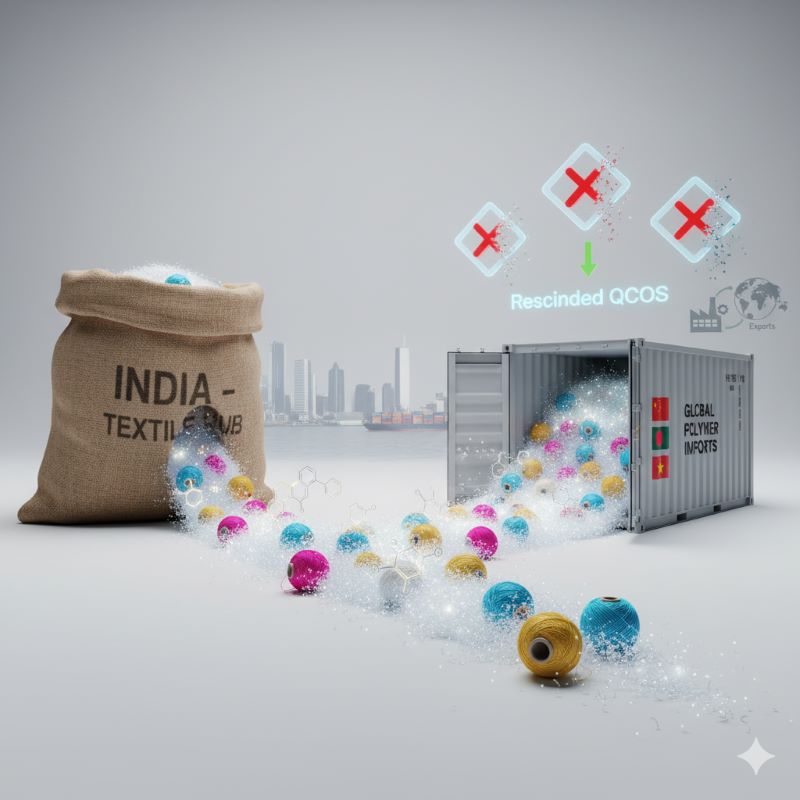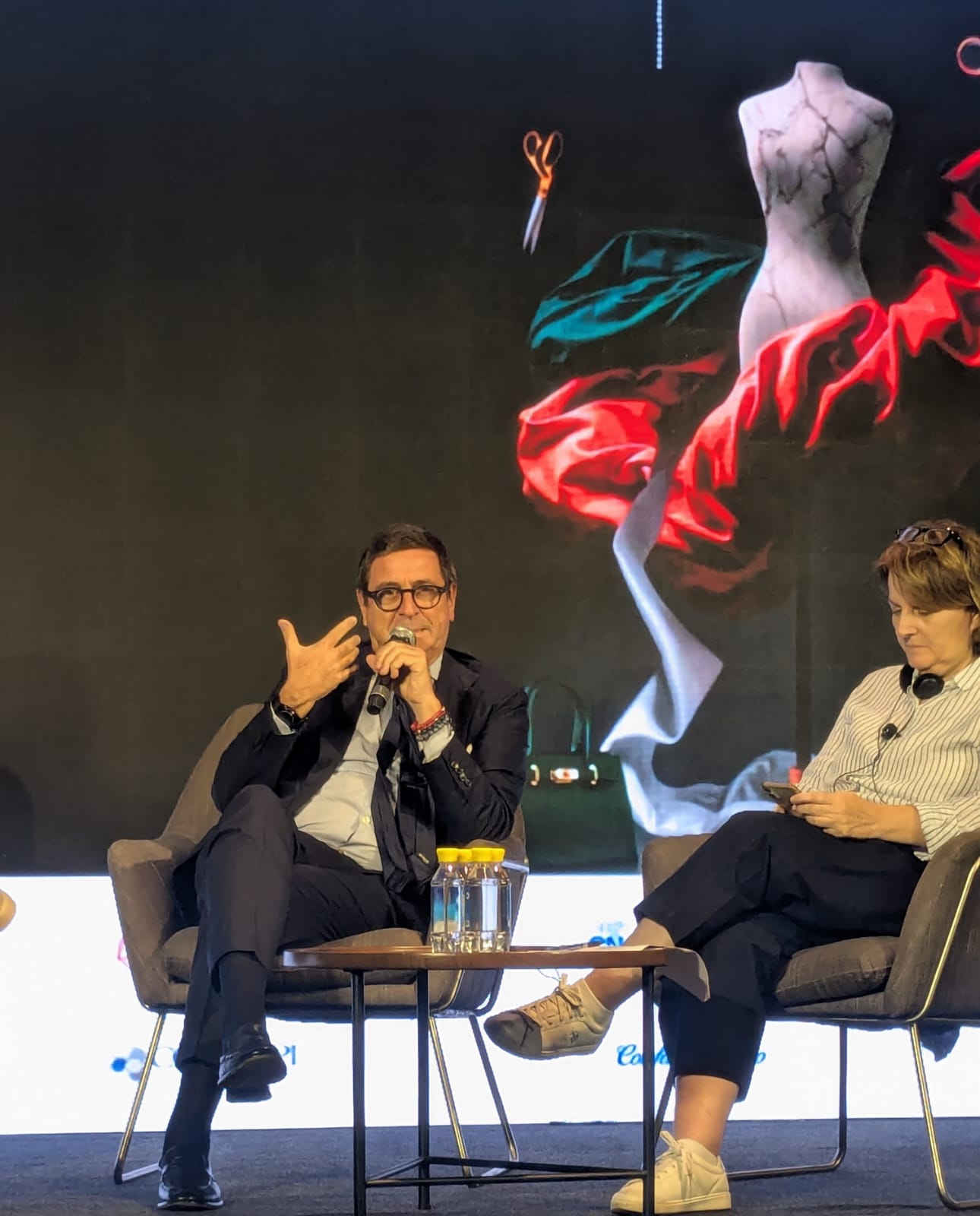FW
Q3, FY25 profit of Indian clothing retailer Arvind Ltd increased by 13 per cent, owing to a strong demand for its textiles during the festive season.
Net profit of the retailer housing international brands like Tommy Hilfiger, Arrow, Calvin Klein increased to Rs 103 crore during the quarter ended December 31,2024 against Rs 91.7 crore in the corresponding quarter a year earlier.
Running from September to January, the festive season traditionally contributes significantly to retailers' annual sales as consumer spending increases during the period.
Arvind Ltd’s revenue from operations grew by 11 per cent during the quarter. This growth was mainly driven by an 11 per cent increase in revenue from its core textile segment, which accounts for 74 per cent of its total sales.
Aided by new customer acquisitions, the company’s textile segment also saw strong volume growth during the quarter, while margins remained stable across segments.
The company also recorded 10 per cent rise in total expenses during the quarter as prices of cotton, its key raw material, remained elevated.
The company’s advanced materials segment, through which it makes fabrics and protective gear for construction work, rose by 9 per cent.
OETI, a globally accredited testing and certification institute and a founding member of the Oeko-Tex Association, will participate in Bharat Tex 2025 at Pragati Maidan, New Delhi, from February 14 to 17. Visitors can meet OETI at Hall 12, Booth 12-A8.
“Our participation highlights OETI’s commitment to the Indian market. As a founding member of Oeko-Tex, we bring extensive expertise to support the industry’s need for quality, sustainability, and compliance with international standards,” said Vignesh Amalraj, OETI’s Country Manager for India.
At Bharat Tex 2025, OETI will offer key insights into sustainability and regulatory compliance for the textile and leather sectors. Highlights include guidance on EU sustainability regulations such as the Corporate Sustainability Due Diligence Directive (CSDDD), Green Claims Directive, and Digital Product Passport (DPP). The institute will also present solutions for consumer safety, product traceability, PPE certification for European markets, and emissions testing.
OETI will showcase its expertise in sustainable chemical management, including ZDHC-approved training to help brands minimize environmental impact. Visitors can also explore Testex Academy, an online learning platform developed by OETI’s parent company, Testex AG, in collaboration with Future Wear Group. The academy covers key topics like the Circular Economy and the EU Waste Framework.
“OETI aims to empower Indian businesses to meet global standards in compliance, quality, and sustainability. By participating in Bharat Tex, we support the industry in navigating challenges and ensuring transparency and due diligence across the supply chain,” said Miriam Scheffelmeier, OETI’s Global Head of Marketing and Sales.
IFC plans to construct a new garment manufacturing facility adhering to highest environmental standards in partnership with Kenyan apparel manufacturer Royal Apparel EPZ. The company also aims to create new jobs, especially for women.
To achieve its goals, IFC will loan Royal Apparel EPZ $15 million to support the construction of the new factory near Nairobi, creating an estimated 3,700 jobs.
The investment is the first to be received from the Canada-IFC advancing Gender Equality, Resilience, Opportunity and Inclusion Worldwide Facility (Canada GROW gender fund). IFC’s investment in Royal is supported by the development of an earlier project including an analysis of the supporting textiles value chain and markets in Africa. Royal is a leading manufacturing company known for high-quality apparel and commitment to sustainable practices. IFC’s financing package is for Royal Apparel EPZ and its associated companies, Royal Garment EPZ and Royal Clothing EPZ, together Royal Apparel Group (Royal).
Partnering with IFC enables the company to leverage their extensive experience and resources to achieve growth objectives and produce high-quality apparel, says Omprakash Shukla, Chairman, Royal Apparel EPZ. The company aims to empower marginalized communities by providing jobs that promote sustainable livelihoods, eradicate poverty, and elevate living standards.
EDGE-certified, Royal’s new factory will feature energy-efficient machinery, and renewable power sources. Developed by IFC, EDGE is a certification tool that recognizes buildings designed to reduce energy and water consumption while incorporating sustainable building materials.
An export-focused apparel manufacturer, Royal supplies its products to major brands in the United States of America and other markets. As part of the financing, Royal will adopt advanced production approaches, including automation, to increase competitiveness. The project demonstrates IFC’s continued commitment towards the industrialization of Africa.
Blue of a Kind and Isko Luxury by PG have collaborated to launch ‘Stories,’ a capsule collection showcasing a shared commitment to responsible fashion.
The collection focuses on upcycling leftover fabrics from Isko Luxury by PG, the high-end range designed by Italian textile designer Paolo Gnutti for the Turkish mill Isko. Gnutti and Fabrizio Consoli, Founder, Blue of a Kind, recognized their complementary aesthetics and shared values, paving the way for this partnership.
Isko provided the leftover fabrics, primarily from discontinued collections and sample production. Blue of a Kind adhered to its sustainable production philosophy, minimizing water usage, eliminating chemicals, and utilizing laser technology for certain garment treatments.
Featuring reimagined Blue of a Kind styles, the ‘Stories’ collection incorporates Gnutti's signature flock denim technique. The designs of this collection emphasize relaxed silhouettes with wider cuts and loose fits for both tops and bottoms, reflecting current fashion trends. The collection includes jeans, trucker jackets, and oversized trench coats, all showcasing the flocked denim aesthetic.
Retail prices for the ‘Stories’ capsule range from 220 to 590 euros (approximately $230-$620).
This collaboration underscores Blue of a Kind's dedication to sustainability. Since its 2018 launch, the brand has focused on upcycling vintage stock to create unique, handmade jeans. In 2019, the brand upcycled a capsule collection from the mill’s sample fabrics in partnership with the Milan-based Candiani Denim. The ‘Stories’ collection with Isko Luxury by PG further strengthens Blue of a Kind's position at the forefront of responsible denim fashion.
Suedwolle Group has developed a new range of home textile fabrics combining wool and Tencel Lyocell fibers in partnership Lenzing and Culp Home Fashions. Aiming to improve sleep comfort and offer innovative textile design, these fabrics blend modern minimalism with vintage patchwork, using angular shapes and a neutral color palette of warm and cool tones.
The wool and Tencel Lyocell blend used in these fabrics regulates sleep temperature by preventing overheating. Their moisture-wicking and breathable properties ensure a dry, comfortable sleep. Tencel Lyocell adds softness, enhances moisture control for a balanced microclimate, and reduces odor-causing bacteria for a more hygienic sleep environment.
The collaboration between Suedwolle Group and its partners focuses on merging functionality and visual appeal, creating a versatile fabric that combines modern and vintage aesthetics.The group’s Oakport Nm 36/1 yarn enhances the fabric's softness, durability, and usability in home textiles.
The partnership also identifies future innovation opportunities, including a core color palette and premium options for broader design applications.
Tommy Bruno, President, Culp Home Fashions, notes, through its collaboration with leading fiber and yarn suppliers, Suedwolle Group creates an innovative foundational fabric for future product development. The group remains committed to exploring new possibilities in textile design and fiber technology.
Picanol launched its new Supermax Rapier loom at SITEX 2025 in Surat, India to target saree fabric weavers. Offering speeds exceeding 400 RPM (for the 340 type), the Supermax surpasses typical speeds in Surat. With reed widths ranging from T190 to T380, the machine caters to all saree weaving demands.
The machine received an overwhelming response at SITEX, reports Sigurd Blondeel, Area Sales Manager, Picanol. As a successor to the GTMax-i 3.0S Connect, the Supermax combines performance with user-friendliness, especially with Picanol’s PicConnect digital platform, he adds.
Designed for wider saree fabrics, the Supermax is available in 340cm, 360cm, and 380cm widths. It can be equipped with a Jacquard and handle up to 12 weft colors. The Smart Cutter, an electronically driven weft cutter, allows individual weft channel cutting time settings for increased precision and efficiency, ideal for diverse saree styles.
Blondeel emphasizes on Surat's importance in Picanol's global strategy, noting the region's shift from shuttle looms to advanced technologies like Rapier looms. The demand for higher-quality fabrics and shuttle loom replacements presents significant potential.
Picanol machines are designed with ‘Intuitive Control,’ ensuring easy operation and a smooth transition to modern technology for weaving mill staff.
Optimistic about Surat's weaving industry in 2025, Blondeel says, announcement of the new textile policy for the state has spurred new investments with Picanol registering increased inquiries and quotations, anticipating a successful 2025 in Surat.
The textile industry faces intense scrutiny as reports reveal alarming levels of toxic chemicals including PFAS, phthalates, lead, and cadmiumin clothing, from children's wear to activewear. These findings raise urgent concerns about consumer safety and environmental impact.
Celebrating 25 years of driving the clean chemical movement, Bluesign, part of SGS’s sustainability portfolio, is leading efforts to eliminate hazardous substances from textiles. With over 800 global partners, its Bluesign System prioritizes clean chemistry, manufacturing, and products to safeguard workers, consumers, and the planet.
A key focus is chemical change management, setting stringent standards to eliminate carcinogenic, mutagenic, and toxic-for-reproduction (CMR) substances while promoting safer alternatives. By collaborating with chemical suppliers, manufacturers, and brands, Bluesign ensures sustainable textile production with minimized resource consumption optimizing water, energy, and chemical use to reduce environmental impact.
As consumer demand for transparency grows, Bluesign remains a trusted leader in sustainability. CEO Daniel Rufenacht emphasizes the industry's pivotal moment:
"For 25 years, we’ve empowered the supply chain to adopt safer, sustainable practices. By collaborating with stakeholders, we’re shaping the future of textilesproving innovation and responsibility go hand in hand."
With rising awareness of toxic chemicals in fashion, Bluesign continues to drive meaningful change, proving that safer, sustainable textiles are not just possible they are essential.

China's textile industry, a behemoth in the global market, navigated a complex landscape in 2024. Despite challenges like global economic uncertainties and fluctuating raw material prices, the sector demonstrated resilience and adaptability. Exports of textiles and apparel witnessed moderate growth, driven by both traditional and emerging economies. However, the industry also faced internal pressures, including rising labor costs and environmental concerns. A key theme that emerged was not a slowing of exports, but rather a strategic shift in destination markets.
Key trends
Overall growth: China's textile and garment exports rose by 2.2 per cent year-on-year, reaching $267 billion between January and November 2024. This growth was further amplified by a surge in December, exceeding expectations.
December rise: Preliminary data from China's General Administration of Customs Exports indicates in December 2024 witnessed an unexpected increase, with a year-on-year growth of 15.8 per cent, reaching $30.2 billion. This surge was largely attributed to anticipation of potential tariff increases by certain countries in January 2025.
Shifting focus: Fabric exports continued to dominate, comprising nearly 80 per cent of total textile exports in the first half of 2024. This highlights China's emphasis on value addition.
Market diversification: While traditional markets like the US and EU remained crucial, China actively explored new export destinations in Southeast Asia, Africa, and Latin America, demonstrating a strategic shift rather than a decline in exports.
Sustainability concerns: Growing awareness of environmental issues and stricter regulations pushed the industry towards sustainable practices and eco-friendly products. For example, companies like Lenzing and Ruyi invested heavily in sustainable fiber production, catering to the rising demand for eco-conscious fashion. This shift towards sustainability reflects the industry's commitment to reducing its environmental footprint.
Technological advancements: Automation and digitalization gained traction, improving efficiency and productivity across the supply chain.
Table: China textiles and apparel exports and destinations (Jan- Dec 2024)
|
Category |
Value ($ bn) |
Year-on-year growth (%) |
|
Textiles (Fibers, Yarns, Fabrics) |
$170 |
3.8 |
|
Apparel |
$132 |
2.9 |
|
Total |
$302 |
3.4 |
|
Shift in export destinations |
||
|
Destination |
Share in 2023 (%) |
Share in 2024 (%) |
|
United States |
25 |
22 |
|
European Union |
20 |
18 |
|
ASEAN |
15 |
20 |
|
Africa |
8 |
12 |
|
Latin America |
5 |
8 |
|
Other |
27 |
20 |
|
Top export destinations |
||
|
Country |
Value ($ bn) |
|
|
United States |
$4.80 |
|
|
Vietnam |
$2.10 |
|
|
Japan |
$1.60 |
|
|
South Korea |
$1.10 |
|
|
Bangladesh |
$1.00 |
December 2024 export growth by category
|
Category |
Value ($ bn) |
Year-on-year growth (%) |
|
Textiles (Fibers, Yarns, Fabrics) |
$18.50 |
18.2 |
|
Apparel |
$11.70 |
13.1 |
The data clearly shows a decrease in the share of exports to the US and EU, while ASEAN, Africa, and Latin America have gained prominence. This strategic shift is due to several factors. First is the diversification strategy to mitigate risks associated with over-reliance on specific markets that China has actively adopted. Take Shein the fast-fashion giant for example it continued aggressive expansion into new markets, leveraging its online platform and agile supply chain. Shein's success underscored the growing importance of e-commerce and consumer demand for trendy, affordable clothing.
Rapid economic growth in emerging markets too presents good opportunities for Chinese textile exporters. Meanwhile, trade tensions with the US and certain European countries have prompted China to explore alternative markets. Moreover China is actively forging regional trade agreements with countries in Southeast Asia, Africa, and Latin America, facilitating trade and reducing barriers.
Growth challenges
However, the industry as it moves ahead is facing its share of challenges. For example, increasing labor and raw material costs are major challenges in the way to maintain price competitiveness. Trade disputes and geopolitical uncertainties too have created volatility in the global market. This was further highlighted by the fear of increased tariffs in early 2025, leading to the December export surge. Stricter environmental regulations required significant investments in cleaner technologies. And growing demand in emerging markets, technological advancements, and the shift towards sustainable practices presented significant opportunities for growth and innovation.
Overall, China's textile industry in 2024 showed resilience and adaptability in the face of various challenges. While maintaining its dominance in the global market, the industry is undergoing a transformation, driven by sustainability concerns, technological advancements, and shifting consumer preferences. The unexpected rise in exports in December 2024 was partly due to anticipated tariff changes, further underscores the dynamic nature of the global trade environment. The data clearly illustrates that China's textile exports are not slowing down, but rather strategically shifting towards new and promising markets. The future of China's textile industry hinges on its ability to innovate, embrace sustainable practices, and navigate the complexities of the global economic landscape.

The global fashion industry is recalibrating its compass, recognizing the vibrant and diverse opportunities across Asia beyond China. While China remains a significant player, brands are increasingly being attracted by the unique potential of other Asian suppliers. With rising incomes, digital adoption, and distinct cultural influences in countries like India, Indonesia, South Korea, Hong Kong, and Thailand are emerging as crucial growth engines for the industry. This shift is evident in the strategic initiatives and impressive growth figures reported by leading fashion brands.
India, a market of a billion aspirations
India's apparel market is expected to reach $118 billion by 2028, with a young demography and increasing disposable incomes. No wonder brands like Zara, H&M, Uniqlo, and luxury giants like Gucci and Louis Vuitton are expanding their footprint.
And to spread their footprint, these brands are adopting various strategies like localized collections. Brands are embracing Indian craftsmanship and design elements to resonate with local preferences. They are also looking at seamless integration of online and offline channels as it is crucial to cater to India's diverse consumer base. And ethical sourcing and production are gaining traction among environmentally conscious consumers.
Table: India brand sales and market share
|
Brand |
Share of sales from India |
Growth in India (YoY) |
|
Zara |
8% |
15% |
|
H&M |
5% |
12% |
|
Uniqlo |
3% |
20% |
Indonesia, the digital fashion frontier
Indonesia's fashion scene is characterized by a thriving e-commerce market, with local players like Zalora and Berrybenka leading the way. International brands like ASOS and Shein are also making inroads, adapting to the digital-first landscape. And to succeed brands have adopted mobile-first approach. They are prioritizing mobile optimization and engaging content to capture the attention of young, digitally savvy consumers. Moreover, collaborations with local influencers are key to building brand awareness and driving engagement.
Table: Indonesia brand sales and market share
|
Brand |
Share of sales from Indonesia |
Growth in Indonesia (YoY) |
|
Zalora |
60% |
25% |
|
Shein |
10% |
30% |
South Korea, the style icon
South Korea's fashion influence extends far beyond its borders, shaping trends in streetwear, K-pop fashion, and beauty across the globe. Luxury brands are vying for a share of the affluent South Korean market, while local brands like Gentle Monster and Stylenanda are gaining global recognition.
Experiential retail is a priority for success in this market. Flagship stores are designed as immersive brand experiences, showcasing cutting-edge design and engaging consumers. Moreover, celebrity collaborations is also crucial. Partnering with K-pop stars and designers amplifies brand visibility and taps into the ‘Korean Wave’
Table: South Korea brand sales and market share
|
Brand |
Share of sales from South Korea |
Growth in South Korea (YoY) |
|
Gucci |
12% |
10% |
|
Louis Vuitton |
10% |
8% |
Hong Kong, the luxury hub
Hong Kong serves as a crucial gateway to the Chinese market and a major shopping destination for affluent tourists. Luxury brands maintain a strong presence, with flagship stores and exclusive events catering to high-net-worth individuals.
Brands are focusing on personalized services and exclusive experiences to cultivate customer loyalty. Also on their agenda is providing seamless shopping experiences across online and offline channels to cater to the digitally savvy consumer.
Table: Hong Kong brand sales and market share
|
Brand |
Share of sales from Hong Kong |
Growth in Hong Kong (YoY) |
|
Chanel |
15% |
7% |
|
Hermès |
12% |
5% |
Thailand, the rising tourist destination
Thailand's growing tourism industry is driving demand for fashion and luxury goods, particularly among Chinese and Southeast Asian tourists. A mix of international and local brands, cater to diverse tastes and budgets, from luxury labels to affordable fast fashion. Brands are investing in large-scale shopping malls with a wide variety of brands and entertainment options. Brands are creating engaging shopping experiences that combine retail with entertainment and cultural elements.
Table: Thailand brand sales and market share
|
Brand |
Share of sales from Thailand |
Growth in Thailand (YoY) |
|
H&M |
6% |
10% |
|
Zara |
5% |
8% |
The Asian fashion landscape is multifaceted, offering numerous opportunities for brands that can adapt to its diverse consumer preferences and market dynamics. With localization, digital innovation, and sustainable practices, fashion companies can unlock the immense potential of these exciting markets and secure their position in the global fashion arena.
The new tariffs on the textiles and apparel industry by the US have sparked concerns amongst industry leaders. Highlighting the effect of these tariffs on business decisions, Stephen Lamar, President and CEO, American Apparel and Footwear Association, says, acting as a tax on the supply chain, these tariffs will ultimately raise prices for consumers and drive their costs significantly.
Echoeing the same concerns, Jonathan Gold, National Retail Federation, emphasizes, forced to pay these tariffs, US imports may ultimately pass on these costs to consumers.
Blake Harden, Retail Industry Leaders Association points out, the trade policy of the new US government indicates a wide range of tariffs on the horizon.
Carlos Couttolenc Lopez, Textiles La Libertad, a Mexican textile company, explains, a tariff of 25 per cent on Mexican and Canadian imports would significantly impact customers, potentially forcing them to raise prices. Under such conditions, it would become extremely difficult to maintain free trade among the US, Mexico and Canada, he emphasizes. An employer of around 160 people, Lopez’ company, Textiles La Libertad relies on the US for a substantial portion of its market share.
Vuong Duc Anh, Vietnam National Textile and Garment Group opines, increased tariffs would ultimately burden US consumers by triggering inflation and impacting the interest rates plans of the Federal Reserve. This would force businesses to find ways to reduce production costs and share the burden with buyers, he adds.












